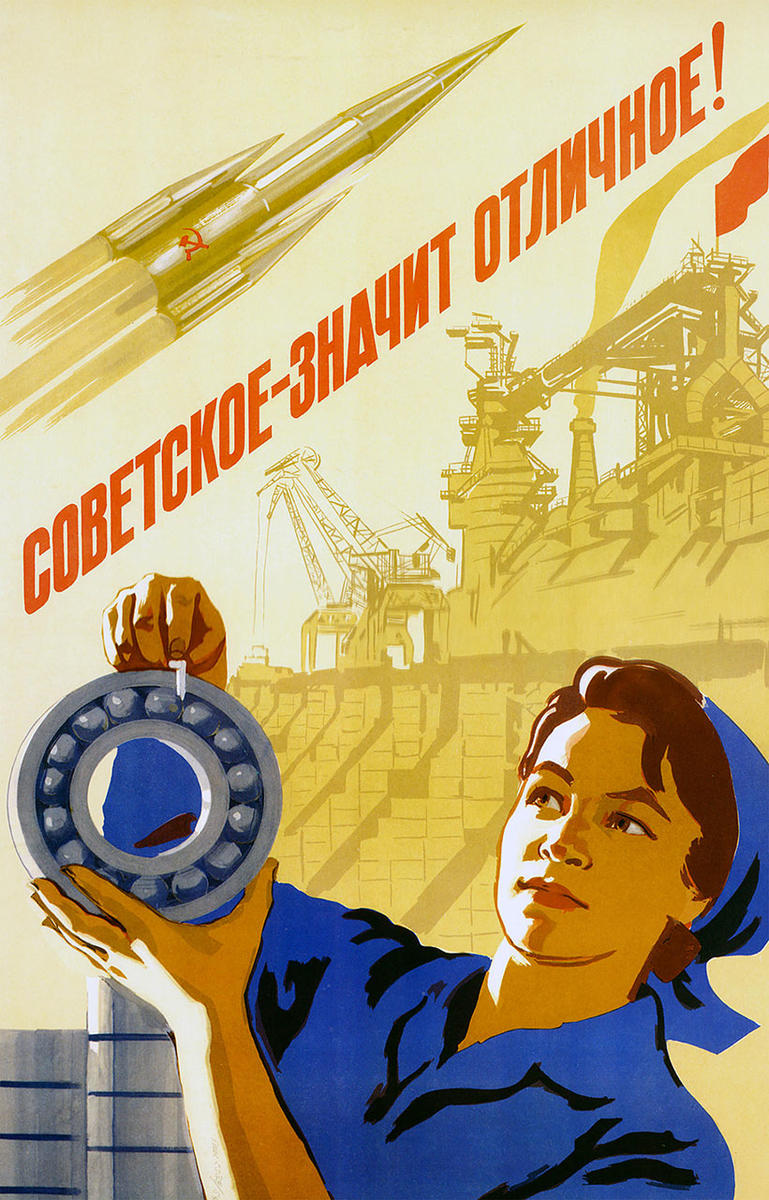Cold War Insights for Evidence-Driven Tech Competition Today
The traditional approach of deploying export controls may have sufficed in the past. But will it prove effective against more innovative foes like the People’s Republic of China?
BY DARROW GODESKI MERTON

Art–iStockPhoto/Hansche
Victory has a thousand fathers, and the outcome of the Cold War is no exception. While scholars largely agree that the Soviet Union was unable to keep pace with the United States because of economic stagnation, they often link this stagnation to their own favored explanations, ranging from the inefficiencies of centrally planned economies and neglect of the consumer sector to economic overextension through costly subsidies to client states.
As technology competition between the U.S. and the People’s Republic of China (PRC) intensifies, analysts have increasingly examined the role that U.S. export controls played in the Soviet Union’s slide from parity to obsolescence, seeking to glean insights relevant today. Although massive differences exist between the technological ecosystems of the USSR and today’s PRC, the Cold War provides the most direct historical comparison available for evaluating the efficacy of export controls.
To “engineer policy” effectively, policymakers must start by defining clear objectives and then continually assess those objectives against real-world outcomes. If we want to build a better evidence-based policy process for technology competition, the Cold War offers a vital, if imperfect, test case. It forces us to ask: What exactly are export controls meant to accomplish, and what does the historical record tell us about whether they achieve those aims?
Conceptual and Legal Foundations of Export Controls
In 1958 Nobel Prize–winning economist and strategist Thomas Schelling defined export controls as a tool of economic warfare meant “to reduce the military strength of another country sufficiently to warrant any costs (including the cost of reduced military strength) that the measures may cause to the country that imposes them.” This strategic objective remains largely the same today, but Schelling’s formulation draws from the groundbreaking Export Control Act of 1949 (ECA), which first introduced peacetime export controls.
The 1949 ECA established three key objectives for imposing export controls: safeguarding national security, advancing foreign policy goals, and addressing short supply. Short supply was only briefly a concern in the immediate aftermath of World War II, and so the rationale of export controls quickly bifurcated into the two categories of national security and foreign policy, with priority placed first on goods and technologies of clear military utility and, secondarily, on ostensibly civilian items that could, by fortifying an adversary’s industrial base, indirectly bolster its military capabilities.
In the ensuing 75 years, there have been only modest refinements to these legislative underpinnings: The Export Administration Acts of 1969 and 1979 incorporated economic considerations like foreign availability and U.S. business competitiveness, while the 2018 Export Control Reform Act (ECRA) further expanded priorities to include preventing terrorism, strengthening the U.S. industrial base, and promoting human rights and democracy. These changes reflect an understanding, articulated by Representative Jonathan Bingham in an influential 1979 Foreign Affairs article, that export controls, much like sanctions, can function not only as instruments to weaken adversaries but also as signaling mechanisms to influence their behavior. Yet, throughout this evolution, the core strategic logic established in 1949—that export controls are first and foremost a tool to maintain a qualitative military edge—has remained fundamentally intact.
Although PRC officials have accused the U.S. of using export controls to hobble China’s economy, the statutory authorities and policy rationale behind U.S. export controls remain centered on military-related technology, not the broader drivers of national power. The 2018 ECRA stresses the need to “preserve the qualitative military superiority of the United States,” while the Department of Commerce under both the first Trump and the Biden administrations has emphasized that the top aim of export controls is blocking U.S. technology from aiding China’s military modernization.
The Unbearable Unmeasurability of Export Controls

A 1950s Soviet propaganda poster reads: “Soviet means it’s excellent!”
Pictorial Press Ltd / Alamy Stock Photo
Because the strategic logic of export controls has changed little since the Cold War, that era is the obvious benchmark for assessing their impact. Unfortunately, there is not much hard evidence, from either contemporaneous accounts or retrospective analyses, on the effectiveness of U.S. export controls targeting the USSR.
The CIA was “consistently bearish” on the effectiveness of export controls because the United States often failed to multilateralize export controls, CIA economist James Noren wrote in 2001, and the USSR usually found substitutes inside the Soviet Bloc.
Despite an “enormous appetite” in Washington for insights on illicit Soviet technology transfer, the CIA struggled to evaluate or measure these efforts, Noren acknowledged. The uncertainty was shared outside the agency: A 1979 Office of Technology Assessment study concluded that while “most observers” agreed Western technology had aided the Soviet military, “there is no agreement on the degree or significance of any such contributions.”
A 1986 CIA report estimated that the Soviet semiconductor industry trailed the U.S. by eight to nine years, a gap the USSR narrowed by importing Western technology, but judged that export controls were only “possibly” a factor in this gap, assigning greater blame to Moscow’s own production and management failings. The same conclusion applies across most sectors: Analysts widely attributed the USSR’s broader technology gap to bureaucratically stifled technological diffusion rather than to U.S. restrictions.
In 1985 economist Morris Bornstein concluded that Western technology transfers to the USSR yielded only modest productivity gains because Soviet industry struggled to absorb them. In one vivid example, a 1975 survey found that years after Xerox sold 4,000 photocopiers to the USSR, many of the machines went unused as 85 percent of Soviet design offices still hand-copied designs with tracing paper. As a 1969 CIA assessment put it, “Even when new plants and equipment are imported, licenses acquired, or foreign technologies merely copied, the modus operandi of the Soviet system delays their introduction and reduces their effectiveness.”
Perhaps the strongest indirect evidence for the effectiveness of export controls is how arduously the Soviet Union lobbied against them. Soviet efforts to disrupt Western solidarity were often successful, since the Coordinating Committee for Multilateral Export Controls (CoCom), the forum established by the U.S. to coordinate export control policy with allies, was a nonbinding arrangement.
The most notorious breach, the Toshiba-Kongsberg scandal, supplied the USSR with $17 million of Japanese computer-controlled machine tools to produce quieter submarine propellers. When this came to light in 1982, Washington imposed sanctions on Toshiba to the tune of $30 billion amid congressional claims that the breach jeopardized U.S. national security. Indeed, if more stringent controls could have averted a relatively small transaction causing tens of billions in damages, it would be a compelling case for robust export controls. The $30 billion estimate, however, was primarily based on a hyperbolic claim that the entire U.S. nuclear submarine fleet would need to be replaced, leaving the actual magnitude of the damage unclear.
From Intuition to Evidence
Export controls have served as a key policy tool—or, to borrow the blunter vernacular of the 1950s, a potent weapon of economic statecraft—for 75 years. Yet their effectiveness has seldom been rigorously evaluated. Without precise metrics, deploying export controls resembles artillery fire without forward observers: potentially powerful but dangerously imprecise.
As Schelling wrote, export control policy is a double-edged sword: It inflicts harm on both target and implementer. This underscores that striking the right balance—making sure the adversary bears the heavier cost—is the crux of effective technology competition policymaking. Consider the U.S. satellite industry. Export controls introduced by the 1999 National Defense Authorization Act aimed at limiting satellite technology transfer to the PRC, but they inadvertently strengthened European competitors. As a result, the U.S. share of the global commercial satellite market dropped from 73 percent in 1995 to just 25 percent in 2005. U.S. market share has since partially recovered to about 50 percent, but this recovery was notably driven by other policy shifts, related to commercial space ventures, not export controls.
Episodes like this one highlight the analytical complexities facing contemporary U.S.-China technology competition. Successful export controls cannot rely solely on strategic intuition; they require continuous, data-driven analysis that accounts for second- and third-order effects, such as Beijing’s industrial policy responses, supply-chain adaptability, domestic substitution capabilities, sectoral investment cycles, impacts on American companies’ R&D spending, and the relationship between technology inputs and downstream military and industrial capabilities.
The Cold War–era approach of deploying export controls with minimal empirical scrutiny may have sufficed against the Soviet Union’s isolated, inefficient technological ecosystem. It will prove inadequate, however, against China’s far more dynamic innovation landscape. Policymakers must therefore embrace an adaptive evidence-based framework grounded in predictive models of technology diffusion and rigorous economic-impact assessments. Such a framework will enable decision-makers to answer critical questions: To what extent do controls accelerate technological substitution and innovation within China? Should restrictions aim only to preserve a qualitative U.S. military edge, or focus on U.S. leadership in critical civilian technologies that underpin economic productivity?
Ultimately, only a data-driven policymaking process will strike the right balance of denying critical technologies to competitors while safeguarding America’s own economic strength. While Commerce owns the export control portfolio, State should supplement its own modest cadre of technology‑focused analysts and reporting officers to collect more evidence on the impact of export controls and loop those findings into policymaking.
When sharing or linking to FSJ articles online, which we welcome and encourage, please be sure to cite the magazine (The Foreign Service Journal) and the month and year of publication. Please check the permissions page for further details.
Read More...
- “Squeezing the Soviets” by Peter L. Kahn, The Foreign Service Journal, February 1982
- “What Is Economic Diplomacy and How Does It Work?” by Tony Wayne, The Foreign Service Journal, January-February 2019
- “Beyond Scale: Three Steps Toward Modernizing the Foreign Service” by Darrow Godeski Merton, The Foreign Service Journal, June 2024





